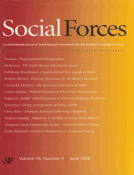-
Views
-
Cite
Cite
Jennifer L. Glass, Lisa Riley, Family Responsive Policies and Employee Retention Following Childbirth, Social Forces, Volume 76, Issue 4, June 1998, Pages 1401–1435, https://doi.org/10.1093/sf/76.4.1401
Close - Share Icon Share
Abstract
Women's labor force decisions following childbirth are often pivotal in determining their later occupational attainment. This article looks at the determinants of job changing and labor force interruptions among employed women following childbirth, focusing on the working conditions and benefits provided by organizations.
Using interviews with 324 randomly selected employed pregnant women, we modeled turnover behavior across the first year postpartum with information on family characteristics, workplace policies in the respondent's last job, and child care use. Results showed that several employer policies significantly decreased job attrition after controlling for the effects of wages, partner's income, and number of existing children- the most important being the length of leave available for childbirth and the ability to avoid mandatory overtime upon return. Supervisor and coworker social support were also effective in preventing turnover among childbearing women. Results also showed some important differences in the causes of turnover that resulted in labor force exits rather than job changes. All else equal, women who held traditional ideas about mothers' responsibilities for home and child care were considerably more likely to experience a labor force interruption following childbirth than others.



